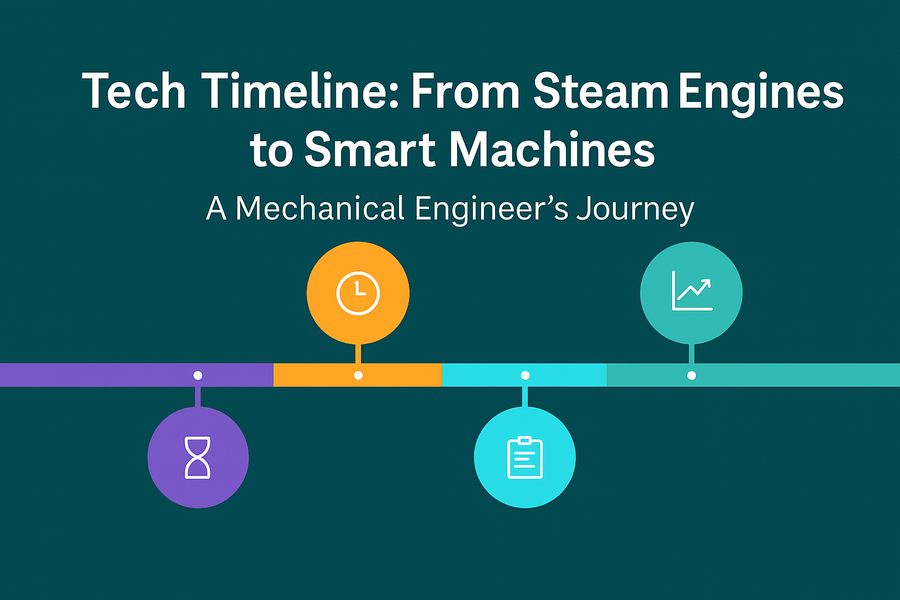Ever wondered how your mechanical mind fits into the story of world-changing technologies?
From the roar of steam engines to the whisper of intelligent algorithms, here’s a journey through the timeline of innovations that shaped not just industries—but the world.
⚙️ 1. The Steam Age – Birth of Mechanical Power (Late 1700s – Early 1800s)
-
Core Tech: Steam engines, spinning jennies, early lathes
-
Impact: First mechanical revolution! Manual labor gave way to machines, giving rise to factories, production lines, and the engineer as a career.
-
Mechanical Takeaway: The concept of thermodynamics, piston mechanisms, and rotary motion took root here.
Risk: Pollution, child labor, and unsafe work conditions became widespread.
⚡ 2. The Electric & Assembly Line Era (Late 1800s – 1900s)
-
Core Tech: Electric motors, railways, mass manufacturing (Ford Model T)
-
Impact: Productivity exploded. Engineers now managed automation systems, gearboxes, and material handling.
-
Mechanical Takeaway: Kinematics, CAD (in its primitive form), and the birth of industrial engineering.
Risk: Urban crowding, resource depletion, and mechanized warfare.
💻 3. The Computer Age (1950s – 1980s)
-
Core Tech: Mainframes, computer-aided design (CAD), CNC machines
-
Impact: Design shifted from paper to pixels. Simulation and prototyping began to thrive.
-
Mechanical Takeaway: The introduction of CAE, finite element analysis (FEA), and numerical control (NC).
Risk: Skill gaps between old-school engineers and new digital tools.
🌐 4. The Internet Boom (1990s – 2010s)
-
Core Tech: Cloud computing, internet of things (IoT), remote monitoring
-
Impact: Remote diagnostics, real-time collaboration, and access to global design resources.
-
Mechanical Takeaway: The rise of mechatronics, smart sensors, and PLM systems in manufacturing.
Risk: Cybersecurity threats, digital burnout, reliance on online-only ecosystems.
📱 5. The Mobile-Social Era (2007 – Present)
-
Core Tech: Smartphones, mobile robotics, 3D printing apps
-
Impact: Access to simulation software on handheld devices, IoT-based production control via apps.
-
Mechanical Takeaway: Rise of cloud-based CAD, digital twin, and real-time equipment tracking.
Risk: Reduced attention span, data overload, and shallow learning.
🤖 6. The AI-Powered Era (2020s – Future)
-
Core Tech: Machine learning, natural language processing, autonomous systems
-
Impact: AI is now predicting failures in machines, optimizing designs, and even co-creating with engineers.
-
Mechanical Takeaway: Skills like AI-integrated CAD, predictive maintenance modeling, generative design, and robotics automation are now critical.
Risk: Job shifts, ethics in automation, AI black-box decisions, and dependency.
🔍 So, What Does This Mean for You—The Mechanical Engineer?
This is your moment. Your core concepts—fluid mechanics, thermodynamics, dynamics, manufacturing, design—are now fused with intelligence.
Mechanical engineering is no longer just about machines — it’s about smart machines.
🛠️ Next Steps:
-
Learn Python + MATLAB for AI-based modeling
-
Explore Digital Twin systems
-
Get hands-on with ML for predictive maintenance
-
Try open-source tools like Fusion 360 with generative design
-
Dive into Mechatronics + Control Systems
🚀 Conclusion:
From James Watt to Elon Musk, the spirit of engineering has always been about shaping what’s next.
As a mechanical mind in 2025, you’re not behind. You’re on the frontline—where design meets intelligence, and motion meets meaning.


